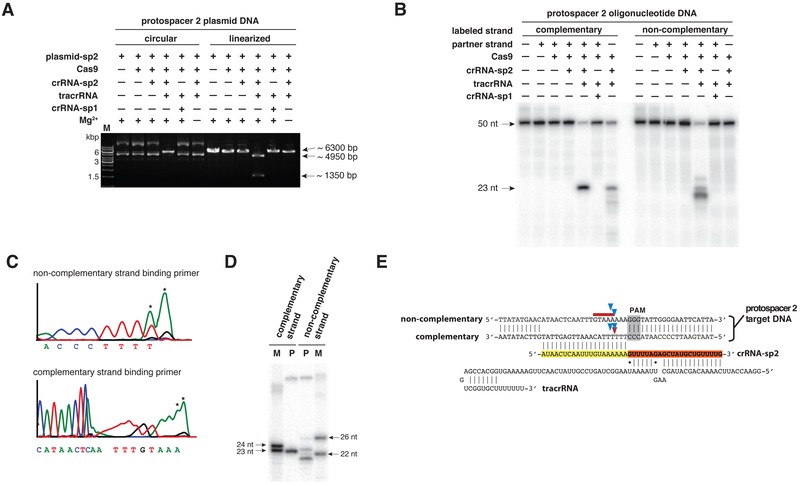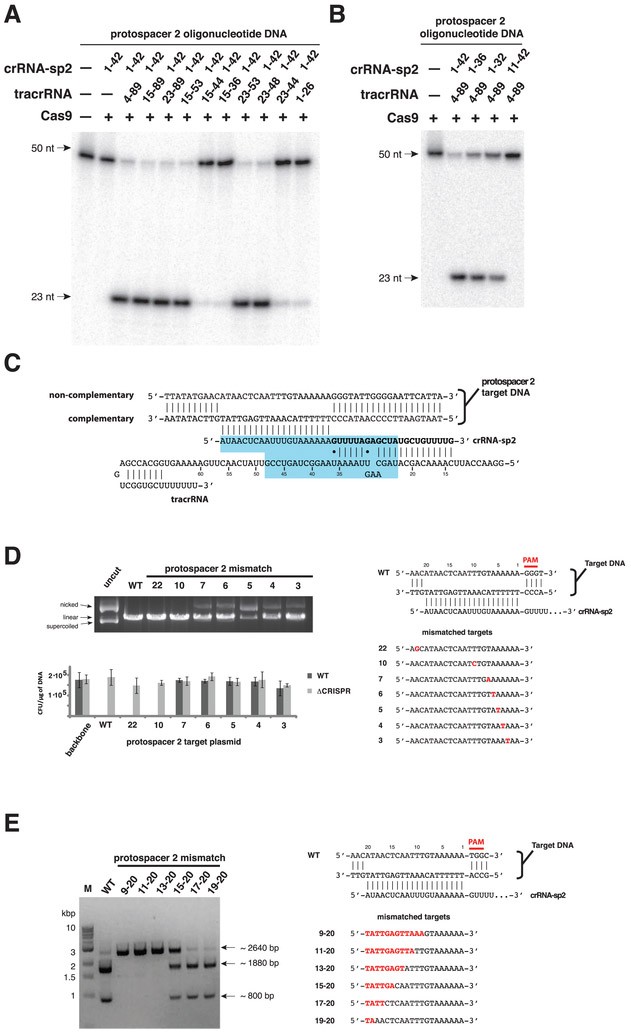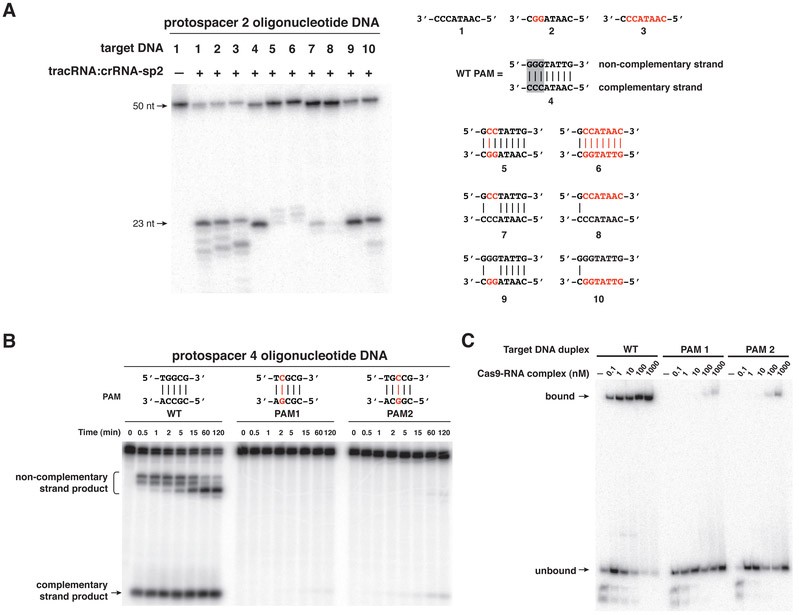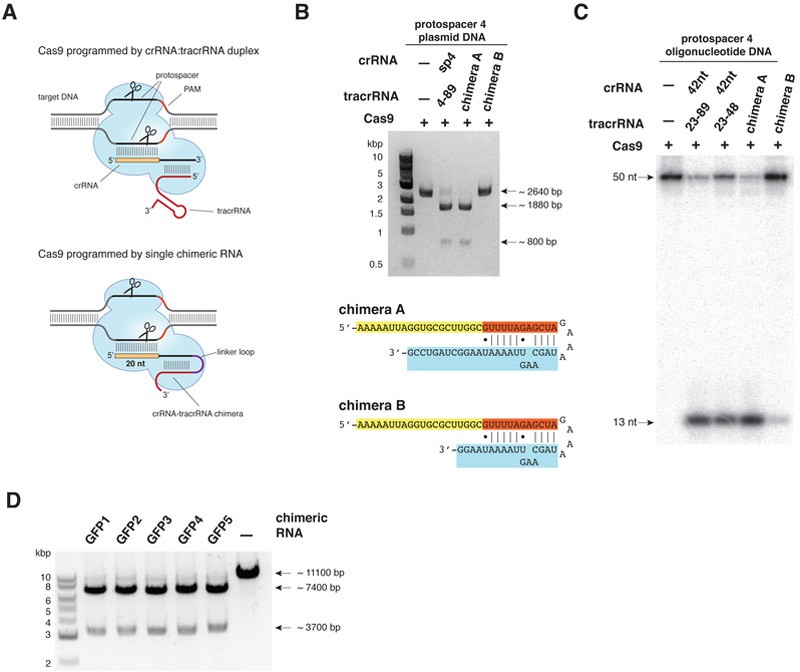In the realm of modern biotechnology, A Programmable Dual-rna-guided Dna Endonuclease stands as a pivotal tool, offering unprecedented precision in gene editing. This technology is reshaping how we approach genetic engineering, disease treatment, and biological research. At CONDUCT.EDU.VN, we delve into the intricacies of this revolutionary system, offering insights into its mechanisms, applications, and ethical considerations. Learn about the DNA cleavage and targeted genome modification facilitated by this groundbreaking technique.
Table of Contents:
1. Understanding the Programmable Dual-RNA-Guided DNA Endonuclease System
2. The Cas9 Protein: A Molecular Swiss Army Knife
3. Dual-RNA Components: tracrRNA and crRNA
4. Mechanism of Action: How the System Works
5. Applications in Gene Editing and Therapy
6. Advantages Over Traditional Methods
7. Challenges and Limitations
8. Optimizing the System for Enhanced Efficiency
9. Ethical Considerations and Safety Measures
10. Future Directions and Innovations
11. Real-World Examples and Case Studies
12. Frequently Asked Questions (FAQs)
1. Understanding the Programmable Dual-RNA-Guided DNA Endonuclease System
A programmable dual-RNA-guided DNA endonuclease, often associated with the CRISPR-Cas9 system, is a molecular tool that allows scientists to precisely target and modify DNA sequences within an organism. This system relies on the Cas9 enzyme, which acts as a molecular scissor, and two RNA molecules—crRNA (CRISPR RNA) and tracrRNA (trans-activating crRNA)—which guide the Cas9 enzyme to the specific DNA location. Understanding the precision genome editing and targeted DNA modification capabilities of this system is crucial for researchers and professionals alike.
The system is considered “programmable” because the guide RNA sequence can be altered to target virtually any DNA sequence, provided it is adjacent to a specific protospacer adjacent motif (PAM) sequence. This adaptability makes it a powerful tool for a wide range of applications, from correcting genetic defects to developing new diagnostic tools.
2. The Cas9 Protein: A Molecular Swiss Army Knife
The Cas9 protein is the heart of the programmable dual-RNA-guided DNA endonuclease system. Functioning as a DNA endonuclease, its primary role is to cut DNA at a specific location guided by the RNA molecules. Sourced from Streptococcus pyogenes, the Cas9 protein has been extensively studied and engineered for enhanced specificity and efficiency. Its DNA targeting capabilities make it an indispensable tool in genetics.
Cas9 contains two nuclease domains: RuvC and HNH. The HNH domain cleaves the DNA strand complementary to the guide RNA, while the RuvC domain cleaves the non-complementary strand. Mutations in either of these domains can result in nickase variants of Cas9, which cut only one DNA strand. These nickase variants are useful for specific applications where a double-strand break is not desired.
Key Features of Cas9 Protein:
| Feature | Description |
| ——— | —————————————————————————– |
| Nuclease Activity | Cuts both strands of DNA at a targeted location |
| Two Nuclease Domains | HNH and RuvC, each cleaving one DNA strand |
| Origin | Streptococcus pyogenes |
| Programmability | Guided by RNA molecules to specific DNA sequences |
| Variants | Includes nickase variants that cut only one DNA strand |
3. Dual-RNA Components: tracrRNA and crRNA
The dual-RNA components of the programmable dual-RNA-guided DNA endonuclease system consist of two essential molecules: tracrRNA and crRNA. The crRNA contains the guide sequence that is complementary to the target DNA sequence, while the tracrRNA acts as a scaffold that binds to Cas9 and facilitates the formation of the active complex. This dual-RNA structure is crucial for targeted DNA cleavage.
Functionality of the RNA Components:
crRNA (CRISPR RNA): This RNA contains a short sequence (approximately 20 nucleotides) that is complementary to the DNA sequence you want to target. This guide sequence directs the Cas9 protein to the specific location in the genome.
tracrRNA (trans-activating crRNA): This RNA acts as a binding scaffold for the Cas9 protein. It forms a complex with the crRNA and ensures that the Cas9 protein is properly positioned to cut the DNA at the targeted site.
In many applications, the crRNA and tracrRNA are fused into a single guide RNA (sgRNA), which simplifies the system and improves efficiency.
4. Mechanism of Action: How the System Works
The mechanism of action for a programmable dual-RNA-guided DNA endonuclease involves several key steps, starting with the design and synthesis of the guide RNA. The guide RNA, consisting of crRNA and tracrRNA, is designed to match the DNA sequence targeted for modification. This targeted DNA cleavage is highly precise.
Once the guide RNA and Cas9 protein are introduced into the cell, they form a complex. This complex searches the DNA for a sequence that matches the guide RNA, adjacent to the correct PAM sequence. The PAM sequence varies depending on the Cas9 protein used, but it is typically a short sequence such as NGG (where N can be any nucleotide).
When the complex finds the matching DNA sequence and PAM, the Cas9 protein unwinds the DNA and compares it to the guide RNA. If there is a match, the Cas9 protein cuts both strands of the DNA, creating a double-strand break.
Steps in the Mechanism of Action:
- Guide RNA Design: crRNA and tracrRNA are designed to target a specific DNA sequence.
- Complex Formation: The guide RNA and Cas9 protein form a complex.
- Target Recognition: The complex searches for the target DNA sequence adjacent to a PAM sequence.
- DNA Cleavage: The Cas9 protein cuts both strands of the DNA, creating a double-strand break.
After the DNA is cut, the cell’s natural repair mechanisms kick in. There are two main pathways for repairing double-strand breaks:
-
Non-Homologous End Joining (NHEJ): This pathway is error-prone and often results in insertions or deletions (indels) at the break site. These indels can disrupt the gene, effectively knocking it out.
-
Homology-Directed Repair (HDR): This pathway uses a DNA template to repair the break accurately. If a DNA template with the desired sequence is provided, the cell can use it to repair the break, resulting in precise gene editing.
5. Applications in Gene Editing and Therapy
The applications of a programmable dual-RNA-guided DNA endonuclease are vast and continuously expanding. In gene therapy, it is used to correct genetic mutations that cause diseases such as cystic fibrosis, sickle cell anemia, and Huntington’s disease. The ability to precisely target and modify genes offers hope for treating and potentially curing these conditions.
In agriculture, the system is used to create crops with improved traits, such as resistance to pests, herbicides, or drought. This can lead to increased yields and reduced pesticide use. The gene targeting and DNA modification capabilities also extend to biofuels, with enhanced strains of algae.
Applications of Programmable Dual-RNA-Guided DNA Endonuclease:
| Application | Description |
|---|---|
| Gene Therapy | Correcting genetic mutations in diseases like cystic fibrosis and sickle cell anemia |
| Agriculture | Creating crops with improved traits such as pest and herbicide resistance |
| Diagnostics | Developing new diagnostic tools for detecting infectious diseases and genetic disorders |
| Research | Studying gene function and developing new disease models |
6. Advantages Over Traditional Methods
A programmable dual-RNA-guided DNA endonuclease offers several advantages over traditional gene editing methods like Zinc Finger Nucleases (ZFNs) and Transcription Activator-Like Effector Nucleases (TALENs). These benefits make it a preferred choice for many researchers.
Advantages of Programmable Dual-RNA-Guided DNA Endonuclease:
| Advantage | Description |
|---|---|
| Simplicity | Easier to design and implement compared to ZFNs and TALENs |
| Efficiency | Higher success rates in targeting and modifying DNA sequences |
| Cost-Effectiveness | Less expensive to produce the necessary components |
| Multiplexing | Ability to target multiple genes simultaneously |
| Specificity | Reduced off-target effects compared to older methods |
7. Challenges and Limitations
Despite its many advantages, a programmable dual-RNA-guided DNA endonuclease is not without challenges and limitations. Off-target effects, where the Cas9 protein cuts DNA at unintended locations, remain a significant concern. These off-target cuts can lead to unintended mutations and potential adverse effects.
Another challenge is delivery. Getting the Cas9 protein and guide RNA into the correct cells or tissues can be difficult, especially for in vivo applications. The immune system can also recognize and attack the Cas9 protein, reducing its effectiveness and potentially causing inflammation.
Challenges and Limitations:
| Challenge | Description |
|---|---|
| Off-Target Effects | Cas9 cutting DNA at unintended locations, leading to potential mutations |
| Delivery | Difficulty in getting the Cas9 protein and guide RNA into the correct cells or tissues |
| Immune Response | The immune system recognizing and attacking the Cas9 protein, reducing its effectiveness |
| Ethical Concerns | Debates surrounding the use of the system for germline editing and other controversial applications |
8. Optimizing the System for Enhanced Efficiency
To enhance the efficiency and specificity of the programmable dual-RNA-guided DNA endonuclease system, researchers are exploring several optimization strategies. These strategies aim to reduce off-target effects and improve delivery methods.
Optimization Strategies:
| Strategy | Description |
|---|---|
| Guide RNA Design | Using algorithms and databases to design guide RNAs with minimal off-target potential |
| Cas9 Variants | Developing high-fidelity Cas9 variants that have reduced off-target activity |
| Delivery Methods | Improving delivery methods using viral vectors, nanoparticles, and electroporation to enhance specificity and efficiency |
| Chemical Modifications | Incorporating chemical modifications into guide RNAs to improve stability and reduce immune responses |
| Protein Engineering | Engineering Cas9 protein to enhance targeted DNA modification |
9. Ethical Considerations and Safety Measures
The use of a programmable dual-RNA-guided DNA endonuclease raises several ethical considerations, particularly when it comes to germline editing, where changes to DNA are passed down to future generations. Concerns about unintended consequences, equitable access, and the potential for misuse have led to calls for careful regulation and oversight.
To ensure safety, researchers are developing guidelines and protocols to minimize off-target effects, monitor long-term outcomes, and ensure informed consent. Robust risk assessment and ethical review processes are essential for responsible innovation in this field.
Ethical and Safety Measures:
| Measure | Description |
|---|---|
| Regulation | Implementing clear guidelines and regulations for the use of the system, especially for germline editing |
| Oversight | Establishing ethical review boards to oversee research and clinical applications |
| Risk Assessment | Conducting thorough risk assessments to identify and mitigate potential adverse effects |
| Informed Consent | Ensuring that patients and research participants are fully informed about the risks and benefits of the technology |
10. Future Directions and Innovations
The future of the programmable dual-RNA-guided DNA endonuclease system is bright, with ongoing research pushing the boundaries of what is possible. New Cas9 variants are being developed with improved specificity and efficiency. Delivery methods are becoming more sophisticated, allowing for targeted gene editing in specific tissues and organs.
Future Directions and Innovations:
| Direction | Description |
|---|---|
| Base Editing | Developing base editing technologies that allow for precise single-base changes without creating double-strand breaks |
| Prime Editing | Exploring prime editing, a versatile and precise genome editing method that can insert, delete, or replace DNA sequences |
| RNA Editing | Expanding the use of RNA editing technologies to correct genetic defects at the RNA level |
| In Vivo Editing | Enhancing in vivo editing techniques to enable gene therapy directly within the body |
11. Real-World Examples and Case Studies
Several real-world examples and case studies illustrate the transformative potential of the programmable dual-RNA-guided DNA endonuclease system. These examples highlight the system’s versatility and impact across various fields.
Real-World Examples:
-
Treatment of Genetic Diseases: The system has shown promise in treating genetic diseases such as sickle cell anemia and beta-thalassemia. Clinical trials have demonstrated the ability to correct the genetic mutation in patient’s cells, leading to significant improvements in their health.
-
Development of Disease-Resistant Crops: In agriculture, the system has been used to develop crops that are resistant to diseases and pests. For example, researchers have created rice varieties that are resistant to bacterial blight, a major threat to rice production.
-
Creation of New Diagnostic Tools: The system has been adapted for use in diagnostic tools that can rapidly and accurately detect infectious diseases. These tools can be used to identify pathogens in patient samples, enabling faster and more effective treatment.
-
Cancer Immunotherapy: The system is being used to engineer immune cells to target and destroy cancer cells. This approach, known as cancer immunotherapy, has shown great promise in treating certain types of cancer.
12. Frequently Asked Questions (FAQs)
Q1: What is a programmable dual-RNA-guided DNA endonuclease?
A programmable dual-RNA-guided DNA endonuclease is a molecular tool used for precise gene editing. It consists of the Cas9 enzyme and two RNA molecules (crRNA and tracrRNA) that guide Cas9 to a specific DNA sequence for cutting and modification.
Q2: How does the programmable dual-RNA-guided DNA endonuclease system work?
The system works by forming a complex of Cas9 protein and guide RNA (crRNA and tracrRNA). This complex targets a specific DNA sequence, unwinds the DNA, and cuts both strands at the targeted site, creating a double-strand break.
Q3: What are the main components of the programmable dual-RNA-guided DNA endonuclease system?
The main components are the Cas9 protein, crRNA (CRISPR RNA), and tracrRNA (trans-activating crRNA). These components work together to target and cut specific DNA sequences.
Q4: What are the advantages of using the programmable dual-RNA-guided DNA endonuclease system over traditional methods?
Advantages include simplicity, efficiency, cost-effectiveness, multiplexing capabilities, and specificity compared to older gene editing methods like ZFNs and TALENs.
Q5: What are the limitations of the programmable dual-RNA-guided DNA endonuclease system?
Limitations include off-target effects, delivery challenges, potential immune responses, and ethical concerns surrounding germline editing.
Q6: How can the efficiency of the programmable dual-RNA-guided DNA endonuclease system be improved?
Efficiency can be improved through better guide RNA design, the use of high-fidelity Cas9 variants, improved delivery methods, and chemical modifications to guide RNAs.
Q7: What are the ethical considerations when using the programmable dual-RNA-guided DNA endonuclease system?
Ethical considerations include concerns about germline editing, unintended consequences, equitable access, and potential misuse of the technology.
Q8: What are the applications of the programmable dual-RNA-guided DNA endonuclease system in gene therapy?
In gene therapy, it is used to correct genetic mutations that cause diseases such as cystic fibrosis, sickle cell anemia, and Huntington’s disease.
Q9: What are some real-world examples of the programmable dual-RNA-guided DNA endonuclease system in action?
Examples include the treatment of genetic diseases like sickle cell anemia, the development of disease-resistant crops, the creation of new diagnostic tools, and cancer immunotherapy.
Q10: Where can I find more information and guidance on the ethical use of the programmable dual-RNA-guided DNA endonuclease system?
You can find more information and guidance on the ethical use of this system at CONDUCT.EDU.VN, which provides resources on ethical standards, compliance guidelines, and educational materials.
At CONDUCT.EDU.VN, we are dedicated to providing comprehensive and reliable information about the programmable dual-RNA-guided DNA endonuclease system. Our goal is to help professionals, researchers, and students understand the intricacies of this technology and its potential to revolutionize various fields. For more detailed guidance, resources, and support, please visit our website or contact us directly at 100 Ethics Plaza, Guideline City, CA 90210, United States, or through Whatsapp at +1 (707) 555-1234. We are here to assist you in navigating the complexities of gene editing and promoting ethical and responsible innovation.
Image URLs & Alt Texts:
{width=800 height=485}
Alt text: Cas9 protein structure, showcasing the HNH and RuvC nuclease domains essential for DNA cleavage, highlighting its role in targeted genome modification
{width=631 height=1032}
Alt text: Illustration of Cas9 nuclease domains with mutations, revealing how these domains contribute to site-specific DNA cleavage within the CRISPR system.
{width=799 height=615}
Alt text: Dual RNA complex with Cas9 protein, demonstrating the essential roles of tracrRNA and crRNA in guiding the endonuclease for precise DNA targeting.
{width=800 height=672}
Alt text: Chimeric RNA design that combines tracrRNA and crRNA features, showing the innovative approach to simplify and enhance the programmability of Cas9 for efficient gene editing.
Actionable Steps for Compliance
| Step | Description | Resources |
|---|---|---|
| 1. Education and Training | Ensure all personnel are trained on responsible and ethical applications of CRISPR-Cas9 technology | CONDUCT.EDU.VN |
| 2. Risk Assessment | Conduct thorough risk assessments to identify potential off-target effects and unintended consequences. | Regulatory guidelines |
| 3. Ethical Review | Establish ethical review boards to oversee research and clinical applications | Institutional Review Board (IRB) |
| 4. Informed Consent | Obtain informed consent from patients or research participants, disclosing all potential risks and benefits. | Sample consent forms |
| 5. Regulatory Compliance | Adhere to all local, national, and international regulations and guidelines governing gene editing. | FDA, EMA |
This comprehensive guide is designed to serve as a vital resource, providing readers with detailed information about a programmable dual-RNA-guided DNA endonuclease and its applications while addressing the practical and ethical considerations necessary for responsible implementation. For further guidance, remember to visit conduct.edu.vn.
